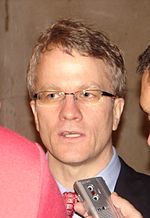2006 Liberal Party of Canada leadership election
Bill Graham (interim) Stéphane Dion In 2006, the Liberal Party of Canada held a leadership election to choose a successor to outgoing leader Paul Martin.
According to media reports, Martin made his decision to end speculation that he may lead the Liberals into the next election, should the Harper government fall in the following few months.
Each candidate had to gather the signatures of at least 300 Liberal Party members, including at least 100 in each of three provinces or territories, and pay a $50,000 fee to enter the contest (down from $75,000 at the previous convention).
[6] As the possibility of a 2006 Liberal leadership convention emerged during the midpoint of the election campaign, most media speculation focused on the surfeit of potential candidates poised to replace Martin.
[9][10][11] In May 2006, The Globe and Mail newspaper reported that the then-eleven candidates were tested for bilingualism certificates by University of Ottawa professor Hélène Knoerr.
The newspaper initially errantly reported that Kennedy and Bevilacqua had failed to meet fluency requirements in French, but later retracted this statement.
Early in the race the field of declared contenders was often described as having a first tier of six potential winners (the "big six") most commonly cited as consisting of Scott Brison, Stéphane Dion, Ken Dryden, Michael Ignatieff, Gerard Kennedy and Bob Rae.
[20] According to an opinion poll[21] of Liberal party members by The Globe and Mail, conducted from September 12–18, Michael Ignatieff enjoyed a slim lead over the pack with 19% support.
The remaining candidates' support was calculated at: 17% for Bob Rae, 13% for Stéphane Dion, 9% for Gerard Kennedy, 9% for Ken Dryden, 3% for Scott Brison, 2% for Joe Volpe, 1% for Martha Hall Findlay, and less than 1% for Hedy Fry.
Still, a poll[22] of Liberal party members in Ontario and Quebec by EKOS Research Associates for the Toronto Star and La Presse, conducted from September 17–24, showed similar results with Rae and Ignatieff supported by 25% each, Dion by 17% and Kennedy by 16%.
Party insiders suggested that Ignatieff would have to secure at least 35% of the delegates elected on "Super Weekend" to avoid being overtaken in subsequent ballots.
An anonymous source speculated to the BBC that Ignatieff's 30-year absence from Canada and his initial support for the U.S.-led invasion of Iraq played against him in the election.
[23] Patrick Gossage, a Toronto political consultant and Ignatieff supporter, explained his eventual loss this way: "There were people saying, 'Who is this telling us what he's going to do with the party?'
"[25] Running second in many polls but with strong second choice support, Bob Rae looked like the most likely candidate to capitalize on Ignatieff's second ballot weakness.
[26] Individuals who gathered the necessary signatures from 300 party members and paid the first $25,000 installment of the entry fee: Scott Brison, 39, was the MP for Kings—Hants and was Minister of Public Works and Government Services under Martin.
Brison crossed the floor later that year to join the Liberals shortly after the creation of the Conservative Party of Canada.
An openly gay former investment banker, Brison presented fiscally moderate and socially progressive positions.
His PC leadership platform had called for Employment Insurance reform, more private involvement in healthcare, integrated defense strategy with the US, and socially liberal policies.
His 2006 Liberal leadership platform emphasised the candidate as a "defender of the environment, business innovation and socially progressive values.
Ken Dryden and Joe Volpe, who both had endorsed Bob Rae after withdrawing, threw their support to Dion before the final ballot as well.
Ignatieff was a staunch supporter of interventionism and favoured the 2003 Invasion of Iraq, despite the conflict's relative unpopularity in Canada (and eventually in the United States).
Ignatieff's campaign was co-chaired by Senator David Smith, a powerful Chrétien organizer and chairman emeritus of Canada's largest "cross-border"[44] law firm,[45] MP Denis Coderre, MP Ruby Dhalla, and was initially headed by Ian Davey (son of Senator Keith Davey), Toronto lawyers Alfred Apps (a party fundraiser and former federal candidate), Daniel Brock (former assistant to John Manley and Irwin Cotler) and Paul Lalonde (son of former minister Marc Lalonde).
[46] Davey, Apps and Brock had originally recruited Ignatieff to return to Canada in 2004 to be part of the Liberal party and eventually run for the leadership.
Gerard Kennedy, 46, was Minister of Education in the Ontario provincial government of Dalton McGuinty from 2003 until 2006 when he resigned to enter the federal Liberal leadership campaign.
Kennedy was a key player in rebuilding the Ontario Liberal Party and bringing it to government in the 2003 provincial election.
While former cabinet minister Joe Fontana continued to support Kennedy, he resigned his seat in the House of Commons during the leadership campaign to run for Mayor of London.
[citation needed] On November 25, The Globe and Mail reported that Justin Trudeau (who would win the 2013 convention and become Prime Minister in 2015) declared support for Kennedy's leadership bid.
[66] Maurizio Bevilacqua formally declared his candidacy on April 19 and withdrew from the race on August 14 to endorse Bob Rae.
The keynote speech at the opening was delivered by Howard Dean, chairman of the U.S. Democratic National Committee, on the topic of party renewal.
Notably, Senator Marie Poulin was elected president defeating Bobbi Ethier and former MP Tony Ianno.












